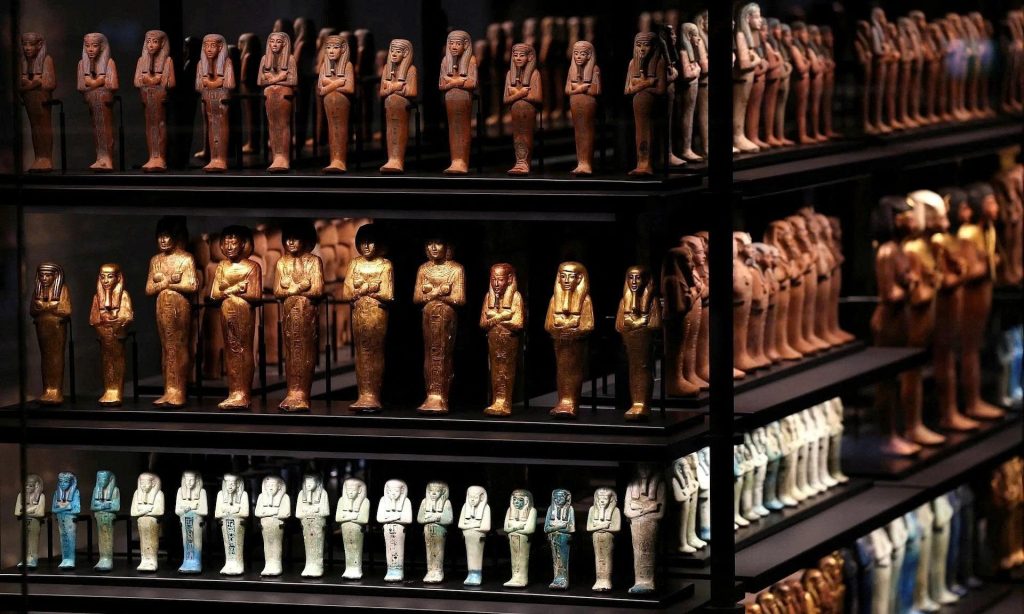More than a century after the sensational discovery of his tomb, the entire, comprehensive collection of treasures belonging to the young Pharaoh Tutankhamun is being presented to the public for the first time. This monumental exhibition is the crown jewel of the Grand Egyptian Museum (GEM), which has finally opened its doors near the historic Giza Pyramids Plateau.
The Grand Egyptian Museum (GEM), situated in the town of Giza, approximately 20 kilometers southwest of the capital Cairo, officially began welcoming visitors on November 4, 2025. This public opening followed an elaborate and long-anticipated inauguration ceremony held on November 1, which saw the attendance of numerous international dignitaries, royal family members, and heads of state, marking a significant moment in global cultural heritage.
Promoted as the largest museum in the world dedicated to a single civilization, the billion-dollar project is an architectural and cultural marvel. It is designed to house and display nearly 100,000 artifacts, offering a chronological journey through Egypt’s illustrious history. Critically, it is the first time that visitors can marvel at the complete assemblage of over 5,000 treasures unearthed from the tomb of King Tutankhamun (KV62) by Howard Carter in 1922.

“The vast majority of Tutankhamun’s precious objects were previously scattered between the old Egyptian Museum in Tahrir Square and various storage facilities,” explained Ahmed Ghoneim, CEO of GEM. “Bringing the entire collection together in this vast, modern space provides a deeply moving, holistic, and unprecedented exhibition experience. It allows visitors to truly grasp the wealth and artistry of the royal court.”
On its initial days of opening, the dedicated Tutankhamun galleries have drawn immense crowds. The spectacular collection, comprising 5,398 artifacts, includes not only the instantly recognizable Golden Burial Mask but also gilded chariots, intricately crafted jewelry, ritualistic weapons, and everyday items, revealing an intimate portrait of the boy-king’s life and death.
Tutankhamun, who ruled for about a decade (circa 1332–1323 BCE) during the 18th Dynasty, remains one of the most famous pharaohs precisely because his tomb was found nearly intact and unlooted. This remarkable preservation offers archaeologists and the public invaluable insight into the culture, religious beliefs, and material sophistication of the ancient Egyptian nobility.

Strategically located on the Giza Plateau, with a clear line of sight to the Great Pyramids, the museum is widely expected to be a powerful engine for economic recovery and a massive boost to Egypt’s tourism sector, which has faced challenges in recent years.
“We project an annual visitor count of around 7 million guests,” Mr. Ghoneim stated, emphasizing that to preserve the quality of the experience and the artifacts, daily visitor numbers will be carefully capped at 20,000.
The genesis of the Grand Egyptian Museum dates back to an announcement in 1992, with construction commencing in 2005. The project faced numerous setbacks and delays over more than two decades, stemming from political instability, financial challenges, and the global pandemic. The completed architectural complex is a masterpiece of modern design, featuring 12 vast exhibition halls and a Grand Staircase that functions as a transitional gallery showcasing monumental statues.
A highlight for many visitors is the Throne of Pharaoh Tutankhamun. Found disassembled in his tomb, the exquisite wooden throne is covered in gold sheet and inlaid with faience, glass, and semi-precious stones. Its back panel features a touching, intimate scene: the young Queen Ankhesenamun anointing the king’s shoulder, a depiction rich in political and personal symbolism.

Another essential exhibit, relocated to the new facility, is the Khufu Ship (Solar Boat). This massive, 4,500-year-old archaeological artifact, one of the world’s oldest and largest intact vessels, was discovered in a sealed pit near the Great Pyramid of Khufu. The ship measures 43.6 meters long and is a stunning example of ancient Egyptian maritime expertise, crafted from Lebanese cedar using a sophisticated technique that meticulously joined the planks without the use of metal nails. The boat is believed to have been intended for use by the Pharaoh’s ka (spirit) in the afterlife, serving the sun god Ra.
Visitors are also captivated by the four nested gilded shrines that once enclosed the sarcophagus and mummy of Tutankhamun. These magnificent, temple-shaped structures, made of gold-plated wood, provided the ultimate protection for the Pharaoh’s remains as he journeyed into the realm of the dead.

The most iconic piece, however, remains the Golden Burial Mask of Pharaoh Tutankhamun. This magnificent artifact, which was placed directly over the king’s head and shoulders, is sculpted from nearly 25 pounds of solid gold, meticulously inlaid with lapis lazuli, quartz, and colored glass. It powerfully conveys the Pharaoh’s divine status and is a peerless testament to the incredible skill of ancient Egyptian jewelers and metalworkers.

Beyond the king’s personal effects, the museum showcases hundreds of ushabti figures. These small statuettes, often made of wood, painted limestone, or glazed faience, were intended to act as servants and substitutes for the deceased in the afterlife, inscribed with magic spells to compel them to perform necessary labor on the Pharaoh’s behalf.

The museum has structured its pricing to encourage global and local appreciation. International adult tickets are set at approximately $24–25, with reduced rates for international students or children at about $13. In a show of national priority, Egyptian citizens benefit from a heavily subsidized entry fee of around $5.
(According to Reuters)
- Thailand Fines Visitors 100,000 baht for Using Reef-Harming Sunscreen
- 15 Top Things to Do in California: Your Bucket List
- Monthly Digital Nomad Budget in Hanoi: Ideal for digital nomads
- Affordable Resorts in Hoian: Discover Hoi An on a Budget
- Cheapest Cities in Vietnam for Digital Nomads: Best Budget Guide

















